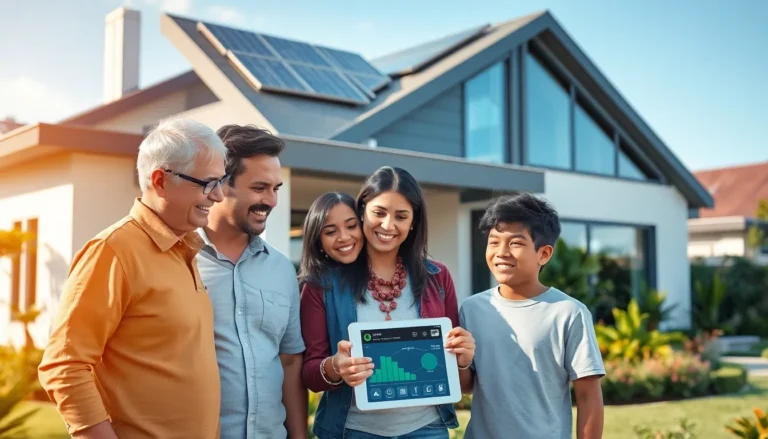In a world where energy bills can feel like a cruel joke, smart energy monitoring systems are the punchline everyone’s been waiting for. These clever gadgets don’t just track energy usage; they turn homeowners into energy ninjas, slashing waste and saving money with stealthy precision. Imagine knowing exactly when your fridge’s midnight snack habits are costing you a fortune or how your teenager’s gaming marathons are impacting the electric bill.
Smart energy monitoring systems bring the power back to the people, making energy efficiency not just a goal but a game. With real-time data at their fingertips, users can make savvy decisions and maybe even impress their friends with their newfound eco-credentials. Say goodbye to guesswork and hello to a smarter, greener future where savings are just a click away.
Table of Contents
ToggleOverview of Smart Energy Monitoring Systems
Smart energy monitoring systems consist of advanced tools that collect and analyze energy usage data. These systems utilize sensors and smart meters to track real-time consumption within a household. Homeowners can gain insights into their energy habits and identify areas where they can reduce usage.
The technology behind these systems supports automated reporting, enabling users to receive alerts about unusual energy spikes or patterns. Data visualization tools often accompany smart energy monitoring systems, allowing users to view their consumption in graphs or charts.
Organizations like the U.S. Department of Energy advocate for smart energy management, emphasizing the positive impact on reducing waste. Users equipped with these systems can engage in energy-saving activities, such as adjusting the thermostat during peak hours.
Notifications provided by smart monitoring systems encourage proactive behavior, leading to significant reductions in energy costs. In households with multiple energy appliances, tracking usage by individual device becomes easy.
Investing in smart energy monitoring systems ultimately promotes energy efficiency and supports sustainable living practices. The financial savings realized from reduced energy bills represent an attractive incentive for many users. Careful analysis of the data can also uncover potential upgrades for increased efficiency, such as switching to LED lighting or energy-efficient appliances.
Through real-time feedback, these systems empower homeowners to make informed choices, fostering a culture of energy conservation. By prioritizing energy efficiency through smart systems, people contribute to a broader effort towards energy sustainability.
Benefits of Smart Energy Monitoring Systems
Smart energy monitoring systems offer numerous advantages for homeowners and the environment. These systems play a vital role in promoting efficient energy use and substantial cost reductions.
Energy Efficiency
Energy efficiency sees a significant boost with these monitoring systems. Homeowners gain insights into consumption patterns through real-time data. Smart devices track energy usage per appliance. Users can pinpoint high-energy-performing devices, allowing for targeted improvements. Reporting features identify wasteful behaviors, prompting necessary changes. By adjusting habits, individuals can maximize energy efficiency throughout their homes.
Cost Savings
Cost savings materialize quickly due to smart energy monitoring systems. Users often discover immediate reductions in energy bills. Real-time alerts about unusual spikes signal potential issues, encouraging swift action. Analysis of usage data helps identify high-cost appliances, paving the way for smarter purchasing decisions. In many cases, this leads to investing in energy-efficient options that lower expenses long-term. The attractive financial incentives motivate proactive energy management.
Environmental Impact
Environmental impact decreases as energy consumption becomes smarter. Homeowners contribute positively by reducing overall waste. Smart energy systems highlight user habits that lead to unnecessary energy use. This awareness fosters a commitment to sustainability. Transitioning to energy-efficient appliances is common and further lessens carbon footprints. Collectively, these efforts support broader societal goals in energy conservation and environmental protection.
Key Features of Smart Energy Monitoring Systems
Smart energy monitoring systems offer essential features that enhance energy management for homeowners. These functionalities cater to various needs, providing insight and control over energy consumption.
Real-Time Monitoring
Real-time monitoring captures energy usage as it happens. Homeowners access instant data on electricity consumption, enabling them to identify patterns. Changes in usage can highlight inefficiencies or surprises like unexpected spikes. By using mobile apps or web dashboards, users track their energy habits effortlessly. Immediate feedback fosters quick adjustments, allowing for prompt energy-saving actions that lead to financial benefits.
Data Analysis and Reporting
Data analysis delivers actionable insights into energy consumption. Advanced algorithms process usage data to present trends and anomalies. Users receive detailed reports that outline energy consumption patterns based on time frames or specific devices. This analysis empowers homeowners to identify high-energy-consuming appliances and make informed adjustments. By prioritizing energy efficiency through educated decision-making, families can optimize their habits, further driving down costs.
Remote Access and Control
Remote access provides flexibility and convenience in energy management. Homeowners can monitor and control energy systems from anywhere using smartphones or tablets. This capability extends to adjusting thermostat settings or turning off devices remotely. Proactive control helps mitigate unnecessary energy consumption, especially during extended absences. As a result, homeowners experience added peace of mind knowing their energy usage can be managed effectively from any location.
Popular Smart Energy Monitoring Systems on the Market
Various smart energy monitoring systems provide homeowners with tools to manage their energy consumption effectively. These systems vary in features and functionalities, catering to different user needs.
System A
The Sense Energy Monitor tracks real-time energy consumption through its smart sensors. It identifies individual devices connected to the electrical system, allowing homeowners to pinpoint energy hogs. Users appreciate how the accompanying mobile app delivers notifications regarding unusual energy use patterns. This system supports integration with smart home devices, promoting enhanced energy management and automation. With an intuitive interface, Sense offers actionable insights, making it easier for users to reduce energy bills.
System B
The Neurio Home Energy Monitor provides detailed analytics about energy usage, including monthly insights alongside real-time monitoring. It tracks consumption patterns to help identify time- or device-specific energy spikes. Users benefit from its cloud-based platform, which enables them to access data remotely. The system also allows for integration with solar panels, promoting renewable energy use. Neurio’s dashboard offers visual representations of energy patterns, empowering users to make informed decisions.
System C
The Emporia Vue Smart Home Energy Monitor delivers comprehensive energy monitoring capabilities with its multi-circuit sensors. It provides real-time usage data across different circuits, helping homeowners understand their energy allocations. Users can access this information via an easy-to-navigate app, which also highlights potential savings. With alerts for unusual consumption patterns, the Emporia Vue enhances proactive energy management. This system’s compatibility with smart home technology amplifies its usability, encouraging efficient energy practices.
Conclusion
Smart energy monitoring systems are transforming how homeowners approach energy consumption. By providing real-time insights and data analysis, these systems empower individuals to make informed decisions that lead to significant cost savings and enhanced energy efficiency.
With features like automated reporting and remote access, users can easily identify energy hogs and adjust their habits accordingly. The positive environmental impact of these systems further supports a commitment to sustainability and conservation.
Adopting smart energy monitoring not only benefits individual households but also contributes to broader societal goals in energy management. As technology continues to evolve, embracing these systems will play a crucial role in shaping a more sustainable future.











